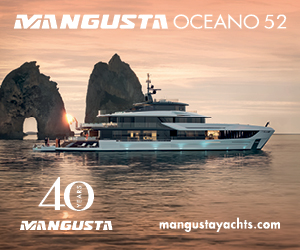Giovanna Vitelli to LN: “Boating tourism in Italy? We could do more. Here’s how”
Giovanna Vitelli, vice-president of Azimut Benetti talks to Liguria Nautica about boating tourism in Italy, on the laws regulating pleasure boating in our country and suggests some ideas on how to make Italy one of the most attractive destinations

Giovanna Vitelli, vice-president of Azimut Benetti talks to Liguria Nautica about boating tourism in Italy, on the laws regulating pleasure boating in our country and suggests some ideas on how to make Italy one of the most attractive destinations
“Boating tourism in Italy is only partially exploited.” These are the words of Giovanna Vitelli, vice president of Azimut Benetti Group. She explains her reasons in person with her speech as part of the volume “Tourismo di Alta Gamma. Leva strategica per l’Italia,” carte blanche by Altagamma, the association for which she is vice president for the boating industry. This is a report of studies, touching on a number of luxury industries, like fashion, motors, hospitality, jewellery, food, and obviously, boating, categorised as driving forces for tourism in Italy.
Giovanna Vitelli highlights the gaps in a country with an extremely high potential, yet still not as attractive as some neighbouring countries, because of a lack of infrastructure, caused by years of disinterest, or worse, lack of foresight, in the political class regarding the boating industry and in a legislation where there is always something missing in order to be efficient and effective.
LN – Ms Vitelli, boating tourism in Italy is similar to what is said about certain students: it is capable but doesn’t do the work. Italian shipyards are the best in the world in the manufacture of super yachts, Italy has 8 thousand kilometres of gorgeous coastline: extremely high potential, but which you say is only partially exploited.” What isn’t working?
GV – In my opinion, there are two parts to this unexploited potential. On the one hand is the infrastructure, so, connected to the type and distribution of our marinas, and another aspect is attractiveness. I’m referring to the legislation, in the more ample sense, of our country.
At the end, the truly successful hubs are the ones where tourists don’t arrive in transit, for a couple weeks in the summer, but ones that project themselves as resident hubs, for the whole year. In order to do this, we need to have a draw, we need to have teams that are easy to reach on site, meaning we need a series of elements that make the boat easy to manage and keep in a certain location. So I would say that these are the two parts that need to be reflected upon, looked at, and hopefully intervened upon.
LN – Let’s talk about ports. The excellence of our marinas, the many services offered and the charming landscapes in which they are located are sometimes not enough for success. Why? Is the problem maybe reaching these ports?
GV – Exactly. And this is where the topic of infrastructure comes in. At the moment we have a very mixed supply of mooring places in our area. Some marinas attract a richer tourist, which then has more returns on the local area.
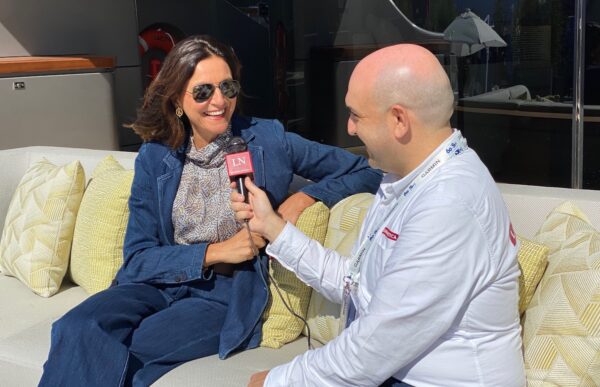
Giovanna Vitelli during an interview with Giuseppe Orrù from LN
The research done by Altagamma looks at this, high end tourism, which, although representing a small percentage of overall tourism in terms of sleeping places etc., returns, in fact 25% on the local area, so it is small but of great value.
Naturally, boating tourism can have a fundamental role, because we, potentially, attract a tourist who may spend more than others, even just with the goods in his possession. This is what is behind our reasoning and contribution to Altagamma.
I was talking about infrastructure: the most attractive, to draw in bigger spending tourists, are the marinas, so places that are not just a “garage” where they can park their boats, but that also has ground services, with a pleasant atmosphere, including restaurants and shops.
Why have the French surpassed us for years now? Because, already at the beginning of the 1970s they set their port development in that direction: meaning that the marinas became places that were also clubs, because all the pleasurable amenities were there, and this is not as widespread in our area.
LN – In Italy though, we have a number of excellent ports.
GV – The best marinas, we have to say, were then developed by private individuals, who had the idea of offering a full service, and not just a place to park. We may have the longest coastline in the Mediterranean, but clients coming by boat need, among these services, certain comforts, including an airport nearby, well-connected roads, restaurants and hotel services of a certain level.
Within our Group, we have a department dedicated to tourist ports. We have opened a few of them over the years, the most recent one being in Malta. One of the first jobs my father gave me was to explore in depth all of southern Italy to understand which, among the many files on the desk containing ports for sale, were of the most interest.
LN – And how did it go?
GV – Naturally, a private individual, like in our case, has a strategic interest, not just a speculative one. With all the ports that we have, we continue to keep more than 50% of the shares on the property because we want to offer quality services to pleasure boaters, and not just a “touch and go” operation. In order to do this, we need to have a certain profitability. In southern Italy, although it is attractive from a naturalistic point of view, there is a strong lack of those infrastructures I mentioned.
With a well-served airport connected to the main European capitals, even with low cost flights, it is much easier to keep a port full of not only local, resident boaters, but also to attract a higher source of richness. This means having good connections to a nearby airport. I came to the conclusion that a private individual on their own cannot do this, you need a shared public/private project, where the private partner does their job in building/managing the marina, but the public partner makes an integrated project, creating a development plan with this aim. And this is what’s missing.
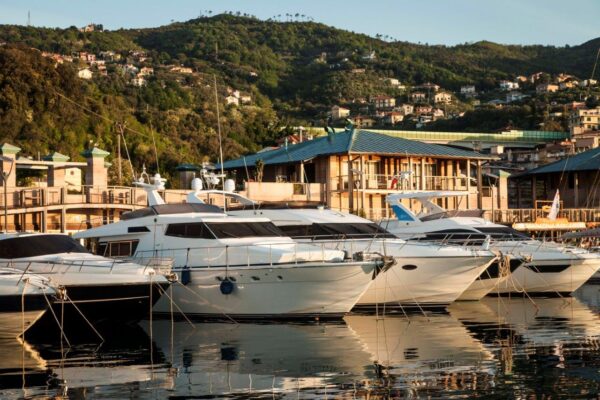
Yachts at the Marina di Varazze
If I was a lawmaker, I would give concessions or at least allow more attention for expansion to those marinas that are already well integrated in their local area. When I have a port connected to a town or inside the town, the use of shops, restaurants, and cultural visits is obviously much more pleasant, thereby making that location much more attractive.
Instead, in Italy we have these famous garages which are a bit far from everything and everyone and make a certain destination, objectively, much less attractive. So, the fact is, that we don’t have too few mooring places, but we sometimes have them in places where the characteristics make them unattractive to the pleasure boater that we want to attract.
LN – Then there is also the relationship with local boaters, who sometimes fear anyone wanting to invest in their area.
GV – I will give you the example of the Marina di Varazze where, from this point of view, we had an excellent public/private partnership. We had to, obviously and happily, reserve a part of the mooring places for residents with reduced rates. First thing, these residents, compared to the old run-down and unsafe port, found themselves in a beautiful marina, well managed, full of greenery, which has resisted all the recent bad weather because it was also well built.
There is always a bit of temporary disgruntlement with local boaters, who feel left out whenever there is an expansion or renewal of a port, but in fact that isn’t the case. Even France does this: favourable regard, democratic of course, to those who already have their boats there, but a push to also attract new people. Sometimes we are missing this push to attract others.
LN – Perhaps some of the responsibility also falls on the Italian political class, with some negligence in regards to boating?
GV – Yes. Absolutely. Maybe because the topic has always been looked at as more of an ideology. What I mean is that boating is a large industry that creates a lot of work, and creates a lot of value for our country. It isn’t the end product that goes to those few rich people on the planet.
At the end, we need to look at the industry that this sector creates. Sometimes things get distorted and the end product is judged for the person who then owns it, but instead, we need to look at what this industry brings to our country and the local areas. Let’s also remember that Italy is the world leader in the construction of mega yachts. Just like we are proud of having Ferrari, and high end fashion, we should also be proud of this industry that, it is true, is targeted at a few lucky individuals, but generates a lot of value in our country.
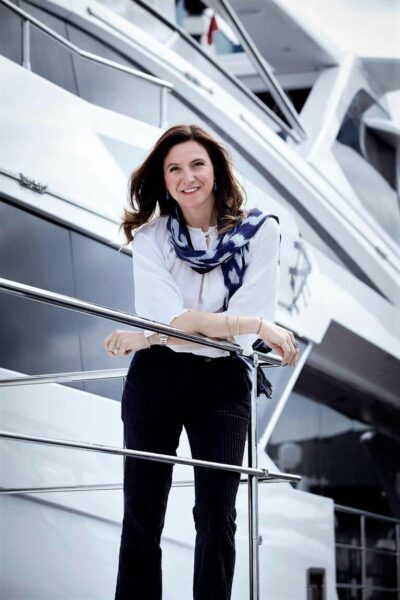
Giovanna Vitelli , vice president of Azimut Benetti Group
And so, it is maybe this point of view that, politically, has always been seen by one government more than another and that is maybe a wrong approach in promoting, instead, what is an important component of our economy.
LN – There is another chapter, bureaucracy. Both for the draw and taxation, which is often penalising compared to neighbouring countries. What would you ask the lawmakers?
GV – If I was a legislator I wouldn’t even touch anyone’s wallet. I would only do two things, which I consider more urgent and that don’t require money, but simply the fulfilment of a political desire and minimal organisation.
Having an attractive draw for large vessels means bringing to Italy objects that reflect significant amounts of money back onto the local area. Normally, just for the ordinary part, so the mooring place, regular maintenance, etc., we can estimate that this is approximately 10% of the value. To this we can easily add another 10% for that which is usually considered to be luxury goods, so what someone spends on shopping restaurants, and other things. Imagine this value and what it means if it stays in our country year round.
There are emblems to the cause that have exploded in their richness, fame and wellbeing, like the Cote d’Azur, Palma de Majorca in the Balearic Islands, and recently, Malta, Montenegro and Greece have been growing. These places, which have advertised themselves as hubs for the entire year for large vessels, objectively have a positive return. In order to do this we need to have a draw.
In our organisation there is, and luckily there have already been, multiple proposals to enact what is called a Registro commerciale bis [Commercial Register]. This register is just waiting on a final ministerial decree, the text of which has already been written and proposed a number of times. So, all we need to do is give this provision a push. This is a register for commercial ships and which simply needs to be adapted for the marina. So we are talking about technicalities, provisions, not funds. This would be a big step forward to be able to say: “Come to Italy, because even in Italy we have an easy draw, easy for large ships.”
The second aspect is the Registro telematico del diporto [Electronic Pleasure Boating Register] This has truly taken years and only starting from the beginning of 2021 has boating has an electronic register. Up until last year, each one of us had to register our boats in person with the Port Authority, who wrote, by hand, in a paper register, the registration number. Now, thankfully, it seems to have been understood that we need an electronic registration system like for car registration.
I will save you from all the stories about the problems that this system has created in regards to fraud, because all that was needed was to register a boat in San Marino, or Italy, and it was difficult for another location to know that the same boat was being registered twice. I won’t even tell you about the mess this system has generated.
LN – No, please tell me. What are the problems?
GV – The problem is that the this electronic register has been made by copying and pasting the one used for car registration. For operators this is a problem, firstly because it is complicated and secondly because we need to turn to the very few maritime agents who have the patience and the willingness to take on this task. I was talking to one of these the other day and they told me: “You know, the situation is dramatic, because there are people who are going to register in Malta instead of in Italy, because they only take three days, and here it takes weeks, or even months.”
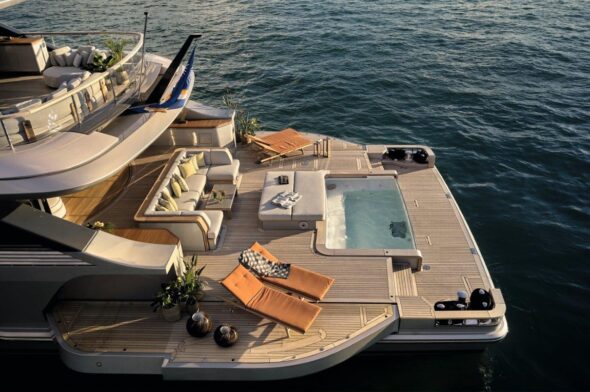
Benetti Oasis 40M is one of the most successful models
And the agent also said to me: “I only have one registered email to write to Rome, so I have no face, just a name, in the office. So, I just sit back and hope that someone replies to this registered email. Which means I can’t even give an owner information on the time it will take, because I don’t know.”
Shipyards have sat down to try and resolve the problem in a practical manner. I remember that more than once I have contacted them, and they have talked to our internal legal office, to help adapt this system to boating, so which fields make sense to use, which aren’t useful, for a digital form. So this is one of things done Italian-style, with lengthiness, lack of desire and willingness to finish a job that makes people angry.
LN – Even uploading documents is complicated, because of the system itself.
GV – Of course, because it isn’t made for boating. So you have to try and creatively upload all the documents and data for a vessel on a system that was made for registering automobiles not boats.
LN – Let’s talk about Azimut Benetti. How has your semester gone?
GV – This is absolutely the year of rebirth. Last year at this time, while we were going through lockdown, with closed shipyards, we never could have imagines this explosion, this boom in boating.
A very strong boom, affecting all sectors. We go from the smallest 40 foot vessel with Azimut to the over 100 metres of Benetti. But we are experiencing a transversal boom in sales, both from those who want, or have wanted, a boat for this season, and thanks to those ordering them, having to obviously wait years for them to be built. So this is a pretty exceptional year, which I explain to myself in two ways.
On the one hand this pandemic has shown everyone how boats are the safest place, one of the few places allowing us to enjoy the freedom we have lost safely, because i can choose to travel with whoever I choose. This has made it very attractive, in addition to the psychological fact that those who have one are more likely to use it, seeing as we have all been hanging by a thread with this pandemic.
Specifically, we have been good and lucky, certainly well appreciated, because this boom arrived at the moment when we launched a whole series of new models under both the Azimut and Benetti brands, which very well interpret the current times and, in certain ways, are truly in line with a change in the approach to living life on board, to boating, which this pandemic has possibly further emphasised.
The idea of living in closer contact with the sea, living with luxury that is maybe more elegant rather than opulent, the fact that we had rediscovered the joy of nature and are paying more attention to the technical aspects and going green. A series of topics that our Group has made its own for some time, but that maybe the current situation has brought to light.
LN – And that you then linked to with the Oasis Deck…
GV – Yes, this is certainly a boat that sums up everything I am saying. But I could say the same thing, in some ways, about this being together, being close to the water, etc., even with the Azimut Verve, both the 42 and 47. I could mention the B.Yond by Benetti currently under construction, where the shipyard believed strongly in the need to adopt Tier III provisions and add the famous catalytic converter, those in urea, far before it became mandatory, meaning for hulls that began construction in 2021.
That boat began construction much earlier, but we decided to put it in because the combination of this benefit, plus the benefit of using the Siemens hybrid system, will make it so that boat, when it touches the water next year, will be one of the greenest solutions existing in the world in its category, with a huge reduction in emissions.
We are defining the sixth unit and the boat still hasn’t seen the light of day, except under construction. So maybe we were also good at catching this wave of recovery with a range of products that maybe best interpret this moment in history.
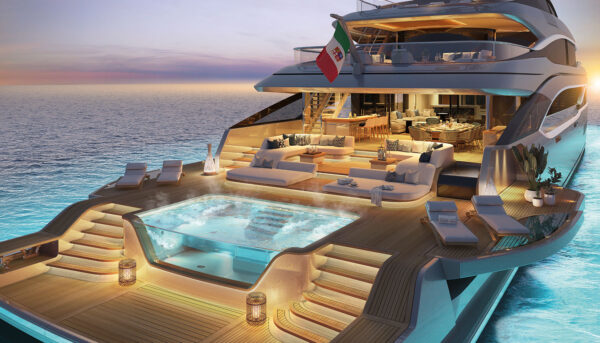
B.NOW 66M Oasis by Benetti
Giuseppe Orrù
Topics: benetti azimut, giovanna vitelli



